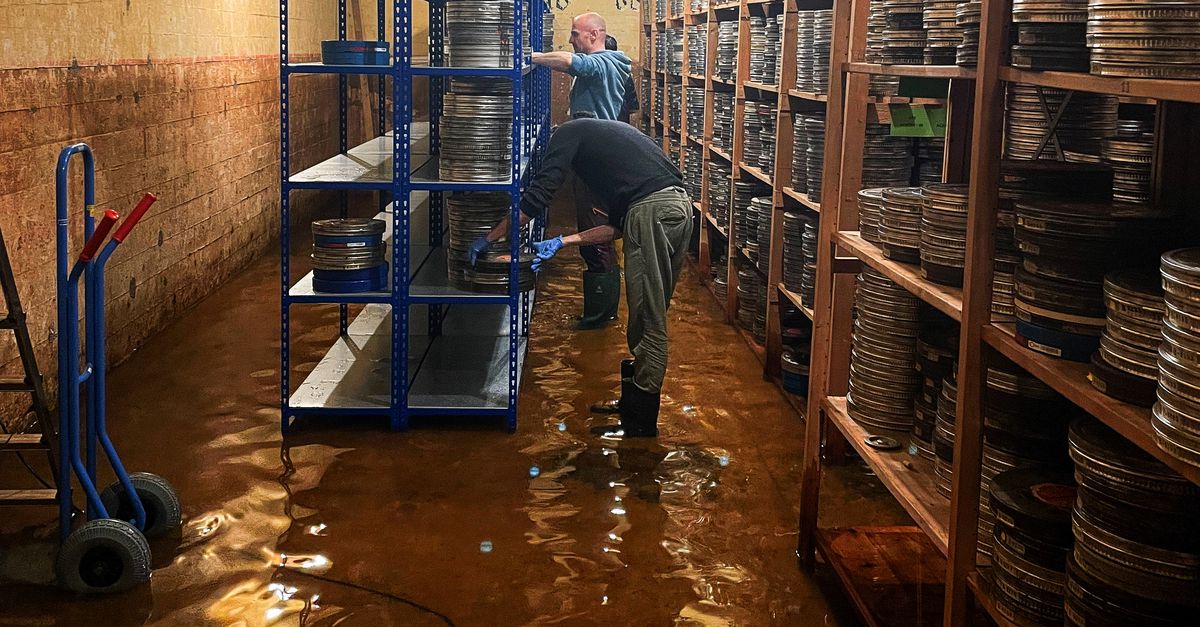“We are currently in crisis mode,” says Frank Romaine, head of collections at the Eye Film Museum. On Tuesday, June 4, a pump at a vulnerable nitrate film warehouse in Castricum broke down to pump out excess water. The pump did not have enough capacity to handle the sudden underground flood. This was likely caused by a leak in the PWN Water Company’s basin, and the investigation is still ongoing. The fact is that the water in the cellar was allowed to run its course unhindered and rose to a height of 25 cm. As a result, films stored at the bottom of rows of shelving units may be damaged.
According to Romaine, it was determined that films in eighty of the seven thousand cans in this cache had come into contact with water. “We have now moved the cans from the lower shelves to a higher area. We blame ourselves for not doing this sooner. Films that have been damaged by water are currently frozen in a private company and then processed at the Haghefilm film laboratory. “Only then can we determine the extent of the damage, no We know that yet.” Although duplicates or digital copies of most films exist, just as record companies store their master tapes, the Eye Filmmuseum also stores original nitrate films.
Technical caches
The bunker at Castricum is one of three bunkers built in 1939 in the sand dunes of northern Holland that Eye uses to store weak nitrate films. Cellulose nitrate, which was the carrier of the photosensitive emulsion layer until 1952, is a flammable material and may not be present in built-up areas due to fire regulations. The caches contain, among other things, the Desmet Collection, the unique audiovisual heritage added to the UNESCO Memory of the World Register in 2011, and amateur films from the 1920s and 1930s, including films from the Dutch East Indies. The Castricum bunker was built to store art collections during World War II, including works by Rembrandt Night guard – That’s why it’s also called an “art bunker.” It then came into use at the Eye Film Museum, which contains the oldest collections of film archives, such as hand-colored films from the early years of the medium.
As soon as the emergency situation was discovered, the fire brigade began removing the vault, and a company came with special equipment to dry the vault. Currently there are still sandbags and special sponges on the concrete floor that absorb excess water. Romijn: “Every day, six people from Amsterdam would go to the basement to check the water damage, look with their own eyes. In general, there are a lot of working hours, which also means that our employees are not busy with what they usually do: saving, restoring and digitizing films.
Climate change
“We realized several years ago that the storage conditions for the Nitrate I range are not ideal,” says Romijn. “Our technical bunkers in Castricum and Heemskerk originally had natural climate control. Because of the thick walls and this natural climate control, the temperature difference between summer and winter is relatively small. We have always been able to cool our nitrate collection there well, but it is getting old. “
According to Romaine, climate change has created a greater risk. For example, the temperature in closets has risen by 2.5 degrees in the past five years. Moreover, due to climate change, it is increasingly raining in the Netherlands. “Add to this the fact that the water company PWN, which manages the dune area, has raised the water table in recent years. This is better for biodiversity in the dunes, but less suitable for artificial bunkers. Due to the high water table combined with heavy rainfall, often “The water level is very high. If you enter the sand dunes in Castricum now, you will walk through the mud. We cannot regularly take the road to the safe with our car that transports nitrate films in special refrigerators to and from Amsterdam, because it sinks in the mud.”
Two things are important for the environment, says Romijn: “Film likes to be cool and dry. Ideally, the temperature should be -5 degrees Celsius and the relative humidity should be around 35 percent. This extends the life of the film. The floods caused the humidity to rise to 90 percent.” Dryers attempt to reduce this extreme moisture, which encourages mold formation.
/s3/static.nrc.nl/images/gn4/stripped/data116980602-ab6d08.jpg|https://images.nrc.nl/7q7sakMZjuB9eF6ZKzfYylmrp7U=/1920x/filters:no_upscale()/s3/static.nrc.nl/images/gn4/stripped/data116980602-ab6d08.jpg|https://images.nrc.nl/aJ3B-gNNMcoERqTm5fdlh2QjTb0=/5760x/filters:no_upscale()/s3/static.nrc.nl/images/gn4/stripped/data116980602-ab6d08.jpg)
urgent
According to Romaine, the climate crisis has increased the urgency to build a new nitrate refuge, especially due to the dire situation in Castricum. He says the other two repositories at Ai are having problems as well. According to him, the situation is so urgent that within a few years there should be a completely new facility for storing nitrates. “The plan for this is already ready. Thanks to the Ministry of Education, Culture and Science, TU Eindhoven has conducted research on modern solid wood film storage at Filmarchiv Austria, focusing on the question of how the Austrian situation is translated into the Dutch situation and whether there have been any changes since the construction of this advanced vault in 2010. New scientific insights are gained, so things get better.
The intention is for the new film storage to be completely energy neutral and sustainable. Power is provided by solar panels, with batteries controlling the cooling process. The building costs 5 million euros, but financing is not yet available. Finding a site is also difficult, as it is not allowed in the Natura 2000 zone, and must be outside the built-up area and preferably in an elevated area in the Netherlands. It must also comply with environmental law and meet Bevi’s safety standards for hazardous materials, Romaine says. It’s a difficult task, but as Rommen says: “A new artistic cache could also be created by other archives that have nitrates in their collection, such as the Institute for Sound and Vision in Hilversum and the Photomuseum Rotterdam.” So that all these groups are future-proof again.
Read also
In 1940, the ship “De Nachtwacht” crossed the Alkmaardermeer on a ferry – and almost fell into the sea






